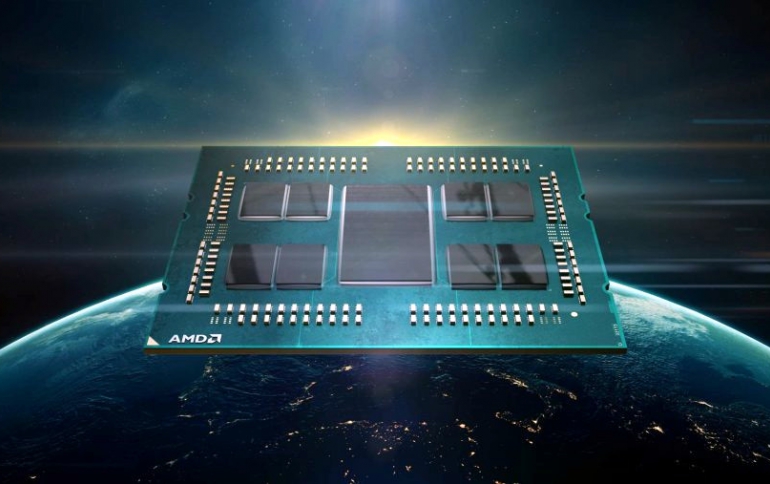
AMD's EPYC Processor Deals in China Helped the Company Get back on Track
AMD was able to decome from a financially struggling company to an investor’s dream in just three years, as a result of a decision to help Chinese partners develop advanced computer-chips mainly for supercomputers.
However, AMD's deals have alarmed U.S. national-security officials, who saw it as a threat to their goal to rein in China’s supercomputing industry. Last week, the Commerce Department issued an order that effectively bars several Chinese entities—including AMD’s partners—from obtaining American technology.
In any case, Chinese versions of AMD chips already have been rolling off production lines. That technology is helping China in its race with the U.S. to build the first next-generation supercomputer—an essential tool for advanced civilian and military applications.
The AMD deal gave China access to advanced x86chips, which are made by only AMD and Intel.
AMD said in a written statement that it “has and will continue to comply with all U.S. laws,” and that the technology transferred to China in the deal wasn’t as high-performing as other U.S. products commercially available there at the time.
Commerce Department officials said last week’s action was made in consultation with other agencies. It followed weeks of inquiries by The Wall Street Journal about AMD’s Chinese partnership and the belief of some government officials that AMD had plotted a sophisticated end-run around regulators.
This account of the protracted battle over the deal between AMD and the government is based on interviews with more than a dozen current and former government officials familiar with AMD’s China deal, senior chip-industry executives, lawyers and company and government filings in the U.S. and China.
When Lisa Su was named AMD’s chief executive in October 2014, the company was desperate for cash, its debts were mounting and its revenue was declining. Its stock had dipped to around $3 a share. Some analysts predicted it would seek bankruptcy protection.
Three weeks after getting the top job, Ms. Su, a Taiwan-born New Yorker, jetted to Beijing to meet officials at China’s Ministry of Industry and Information Technology. A Chinese vice minister urged her to partner with China “to achieve mutual benefits based on AMD’s technological strength,” according to a ministry press release at the time.
AMD reached the first joint-venture deal in 2016. The deal was between AMD and a leading Chinese supercomputer developer, a state-backed military supplier called Sugon Information Industry Co., to make chips licensing AMD’s x86 processor technology. In exchange, the Chinese government gave AMD $293 million in licensing fees plus royalties on the sales of any chips developed by the venture.
Some months later, AMD said it would get a $371 million payout for selling an 85% stake in two of its semiconductor factories in China and Malaysia to an entity controlled by China Integrated Circuit Industry Investment Fund Co., a state-backed financier known as “the Big Fund.” Its mission is to develop China’s indigenous chip industry.
In June 2017, following a series of inquiries, the U.S. Commerce Department sent AMD an “is informed letter” that alerted the company they suspected the China deal violated export controls.
"Starting in 2015, AMD diligently and proactively briefed the Department of Defense, the Department of Commerce and multiple other agencies within the U.S. Government before entering into the joint ventures. AMD received no objections whatsoever from any agency to the formation of the joint ventures or to the transfer of technology – technology which was of lower performance than other commercially available processors. In fact, prior to the formation of the joint ventures and the transfer of technology, the Department of Commerce notified AMD that the technology proposed was not restricted or otherwise prohibited from being transferred. Given this clear feedback, AMD moved ahead with the joint ventures," AMD said.
AMD added that it put significant protections in place to protect its intellectual property (IP) and prevent valuable IP from being misused or reverse engineered to develop future generations of processors.
"AMD’s belief is that it did everything correctly and transparently in interactions with the US Government in advance of and since forming these joint ventures. We recognize that there are increased sensitivities and concerns today around national security and technology," AMD said.
In compliance with the amended U.S “Entities List,” AMD says it has restricted the sale and purchase of products and taken steps to ensure that no technology transfers occur to listed entities.
According to the Wall Street Journal, the x86 chips under development for China, code-named Dhyana, are similar to AMD’s own EPYC chips, minus U.S. encryption technology that AMD omitted.
The joint venture’s U.S. managers stressed to employees that the Dhyana chip was being developed for commercial purposes, such as providing processing technology to Chinese tech giants such as Baidu Inc. or Tencent Holdings Ltd. , according to one of the people familiar with the deal.
Sugon, however, told state-run media that the x86 technology could serve China’s bid to build the world’s first exascale supercomputer. The joint venture’s job postings in Chinese implore candidates to help strengthen China’s domestic chip ambitions.
On June 21, the Commerce Department announced the new export restrictions banning Sugon and its affiliates on the AMD deal from accessing U.S. technology without a license. The move, which followed the imposition of similar export restrictions last month targeting Chinese telecommunications giant Huawei Technologies Co., effectively forces AMD to unwind the deal.





















